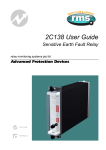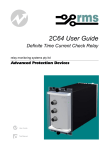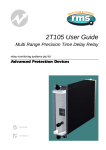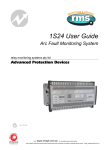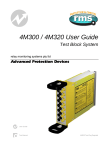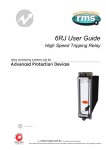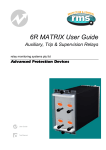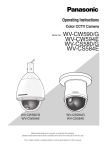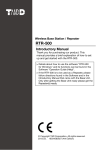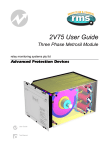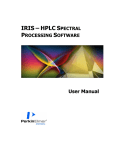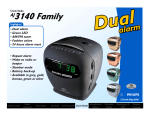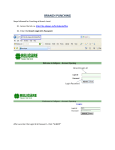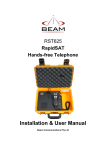Download 2C73 User's Guide
Transcript
1S20 User Guide Arc Fault Monitor relay monitoring systems pty ltd Advanced Protection Devices User Guide Test Manual 1S20 User Guide About This Manual This User Guide covers all 1S20 relays manufactured from June 2005. Earlier relays do not necessarily incorporate all the features described. Our policy of continuous may means that extra features & functionality may have been added. The 1S20 User Guide is designed as a generic document to describe the common operating parameters for all relays built on this platform. Some relay applications are described but for specific model information the individual “K” number Product / Test manuals should be consulted. The copyright and other intellectual property rights in this document, and in any model or article produced from it (and including any Registered or unregistered design rights) are the property of Relay Monitoring Systems Pty Ltd. No part of this document shall be reproduced or modified or stored in another form, in any data retrieval system, without the permission of Relay Monitoring Systems Pty Ltd, nor shall any model or article be reproduced from this document without consent from Relay Monitoring Systems Pty Ltd. While the information and guidance given in this document is believed to be correct, no liability shall be accepted for any loss or damage caused by any error or omission, whether such error or omission is the result of negligence or any other cause. Any and all such liability is disclaimed. Contact Us © Relay Monitoring Systems Pty Ltd 2001-2005 6 Anzed Court • Mulgrave 3170 • AUSTRALIA Phone 61 3 9561 0266 • Fax 61 3 9561 0277 Email [email protected] • Web www.rmspl.com.au To download a PDF version of this guide: http://www.rmspl.com.au/userguide/1S20_user_guide.pdf To download the model specific Test Manual: http://www.rmspl.com.au/search.asp How this guide is organised This guide is divided into five parts: Part 1 Overview About this Manual Contents Test Manual Part 2 Mechanical Configuration Part 3 1S20 Arc Fault Monitor Technical Bulletin 1S30 Arc Fault Sensor Technical Bulletin Part 4 Installation Handling of Electronic Equipment Safety Unpacking Mounting the 1S20 Arc Fault Monitor Mounting the 1S30 Arc Fault Sensors 1S20 Configuration Switches Equipment Connections Operating Conditions Part 5 Maintenance Mechanical Inspection Speed of Operation Performance Testing Test Intervals Defect Report Form Visit www.rmspl.com.au for the latest product information. Due to RMS continuous product improvement policy this information is subject to change without notice. 1A54_Guide/Iss B/24/07/06 Part 1 Test Manual This User Guide covers all 1S20 relay versions & describes the generic features & attributes common across all versions. Different relay versions are required to cater for varying customer requirements such as auxiliary voltage range, I/O configuration, case style, relay functionality etc. The product ordering code described in the Technical Bulletin is used to generate a unique version of the relay specification & is called a type number. The type number takes the form 1S20Kxx where the Kxx is the “K” or version number. www.rmspl.com.au/handbook/PARTA3.pdf Refer to: for a complete description of the RMS “K” number system. Each 1S20 version has a specific Test Manual which provides details on the unique attributes of the relay. Each Test Manual includes the following information: • Test Certificate • Specific technical variations from the standard model if applicable • Test & calibration record • Wiring diagram A Test Manual is provided with each relay shipped. If you require a copy of the Test Manual for an RMS product the following options are available: • Check the RMS web site at: www.rmspl.com.au/search.asp • RMS CD catalogue select: List all Product/Test Manuals under Technical Library • Contact RMS or a representative & request a hard copy or PDF by email. Visit www.rmspl.com.au for the latest product information. Due to RMS continuous product improvement policy this information is subject to change without notice. 1A54_Guide/Iss B/24/07/06 Part 2 Mechanical Configuration Great care has been taken to design a rugged, cost effective & flexible mechanical solution for the 1S20 series Arc Fault Monitor. The ZA12 case MATRIX range provides a compact draw out case solution with M4 screw terminals: • • • 1S20 surface mount type 1S20 panel mount type 1S30 arc sensor ZA12 plastic case suitable for surface or DIN rail mounting ZA12 plastic case suitable for through hole panel mounting Surface mounting plastic mousing The 1S20 is configured in a ZA12 case & the following photographs depict the general mechanical configuration. Front view of panel mount version Note combined tri-colour LED & reset button Visit www.rmspl.com.au for the latest product information. Due to RMS continuous product improvement policy this information is subject to change without notice. 1A54_Guide/Iss B/24/07/06 Front view of surface mount version Note separate tri-colour LED, reset button, type number detail & retention screws Rear view of 1S20 Arc Fault module Note wiring diagram & configuration switches Visit Rear view of panel mount version terminal base Note type number detail & retention screws www.rmspl.com.au for the latest product information. Due to RMS continuous product improvement policy this information is subject to change without notice. 1A54_Guide/Iss B/24/07/06 1S20 Arc Fault Monitor shown un-plugged from terminal base Note gold PCB contacts Internal view of panel mount version PCB Note combined tri-colour LED & reset button Visit www.rmspl.com.au Internal view of surface mount PCB Note separate tri colour LED & reset button for the latest product information. Due to RMS continuous product improvement policy this information is subject to change without notice. 1A54_Guide/Iss B/24/07/06 Part 3 Technical Bulletin The detailed technical attributes, functional description & performance specifications for the 1S20 are described in the attached Technical Bulletin. For the most up to date version go to: www.rmspl.com.au/handbook/1S20.htm For any specific attributes of a particular version refer to the Test Manual for that type (K) number. The order of precedence for technical information is as follows: • • • Test Manual Technical Bulletin User Guide Visit www.rmspl.com.au for the latest product information. Due to RMS continuous product improvement policy this information is subject to change without notice. 1A54_Guide/Iss B/24/07/06 Technical Bulletin 1S20 Arc Fault Monitor Relay Features Compact, economic design Simple panel mounting for retrofit applications Two or three arc sensor inputs Two high speed tripping duty arc sense output contacts Push button reset Continuous arc sensor supervision Integrated self supervision Fail alarm contact 20-60 & 36-150V DC auxiliary versions Introduction Medium voltage switchgear is a key element in the power supply chain. Existing protection systems operate effectively under most circumstances, but they are too slow to handle arcing short circuits. Arcing faults can occur as a result of insulation breakdown due to equipment age & / or poor maintenance. The degree of damage caused by arcing depends principally on the duration of the arc. If an arc lasts only 100ms, the switchgear needs to be checked & the insulation resistance measured before power can be re-established. With a 200ms arc, the power supply will be interrupted; the switchgear must be checked; power is re-established only after minor repairs. In the event of a 500ms arc the supply is interrupted, metal parts of the switchgear are destroyed & poisonous gases are emitted. A 1s arc destroys most of the switchgear & may cause a fire, injury to personnel & damage to property. The over-current caused by an arc is, due to its resistance, lower than the overcurrent caused by a “metallic” short circuit. The over-current caused by the arc may also be lower than the protection start current when energising circuits or starting large motors. The consequence of these conditions is that a protection system based solely on over-current detection cannot effectively discriminate between normal system currents & an arc fault condition: 1S30 Sensors - front & back ARC Fault Protection 1S20 depicted in panel mount case configuration Made in Australia Arc fault protection is a relatively new technique employed for the fast clearance of arcing faults on BUS bars & within metal clad switchgear & associated cable boxes. The arc is detected using an optical sensor & the signal input to a protection device which also monitors the load current on the system. A trip signal can be achieved in less than 10ms using arc detection only or within 15ms when using overcurrent check. This is considerably faster than a traditional IDMT overcurrent relay & provides additional protection from the onset of arcing faults with relatively low fault currents. Arguably the greatest risk of arc fault damage exists at the CB cable termination & in the CB chamber itself due to the slow clearance times of the IDMT feeder protection. The CB cable termination is particularly at risk to ingress of moisture & rodent damage. The problem of arc faults is most prevalent in older metal clad switchgear which already has operational protection systems. The 1S20 Arc Fault Monitor has therefore been designed for the following applications: EXISTING SWITCHGEAR Where a requirement exists to retrofit arc fault protection to metal clad switchgear utilizing the existing overcurrent protection relay; NEW SWITCHGEAR Where a requirement exists to install arc fault protection to new switchgear for integration with the customer preferred overcurrent feeder protection relay. • For moderate arc fault currents the trip time of the over-current IDMT stage will be too slow; • For very low arc fault currents the instantaneous trip stage of a standard over-current relay cannot be set low enough. www.rmspl.com.au Visit for the latest product information. Due to RMS continuous product improvement policy this information is subject to change without notice. 1S20/Issue R/28/02/2010 - 1/11 Switchgear Applications SWITCHGEAR ARC PROTECTION Risk of arc fault damage exists at the CB cable termination & in the CB chamber itself. The CB cable termination is particularly at risk to ingress of moisture & rodent damage. One, two or three arc sensors may be connected to the 1S20 Arc Fault Monitors as depicted in the single line application diagrams at right. Figures 1 & 2 show the trip signals being used to trip the feeder circuit breaker in the event of an arc fault occurring at any sensor provided the overcurrent relay starter contact is picked up. In these applications the overcurrent check stage is optional as the consequence of a single feeder outage is less than the loss of an entire BUS. Figure 3 shows an application where a single 1S20 is applied for the protection of the Cable box, CT chamber & CB chamber using three sensors. In this configuration one arc trip output is used to trip the feeder circuit breaker in the event of an arc fault in the cable box / CT chamber. The second trip output is set for independent operation to trip the BUS breaker (BUS overcurrent check not shown), in the event of an arc fault in the CB chamber. 50/51 1S30 1S20 Figure 1: Single arc sensor - Cable box only (Optional overcurrent check stage depicted) EXISTING SWITCHGEAR APPLICATIONS The existing overcurrent relay protecting the feeder will normally provide an independent output contact associated with the start current setting of the relay. That is an output contact that will close when a phase or earth fault current is detected above the threshold which starts the internal relay timers. This starter element should be set for instantaneous operation so that it will pick up in the order of 15ms. An Arc Fault Monitor relay 1S20 is installed on the switchgear panel adjacent to the protection relay. The 1S20 is specifically designed for simple retrofit to existing panels & requires only a single 31mm mounting hole to be drilled. The 1S20 fits through this hole, the designation label supplied with the unit positioned & the retention shroud fitted. Refer Figure 12 & 13. 50/51 1S30 1S30 optical arc sensors are fitted in the cable termination box & CT chamber as depicted in figure 2. The overcurrent relay starter contact may optionally be wired in series with the arc fault detection trip output contact as depicted in figure 6. The resulting “AND” function trip output is wired to trip the breaker in ~15ms in the event that an arc fault is detected while the overcurrent start element is picked up. 1S30 1S20 Figure 2: Two arc sensors - Cable box & CT chamber (Optional overcurrent check stage depicted) The second arc trip & fail alarm contacts may be employed for interface to a SCADA system for fault reporting. NEW SWITCHGEAR APPLICATIONS For new switchgear installations a modern numeric feeder protection relay is likely to be employed which will have numerous programming & configuration options. The basic concept is the same as for the existing switchgear application described above except that the additional features & flexibility of modern feeder protection relay allows improved system integration. This may be achieved by using the second arc trip output contact to interface to a programmable status input on the feeder protection relay. Depending on the model of protection relay being used this input may be programmed to provide an alarm message on the HMI, time stamped event record available via its communications link. Where this level of system integration is employed the 1S20 does not need to be mounted on the front panel as the alarm indications are available on the feeder relay. Remote reset of the 1S20 LED is achieved by momentary interruption of the power supply using a SCADA controlled series contact. The DIN rail mounting option is a convenient alternative in this situation. Trip BUS CB(s) 1S30 50/51 1S30 1S30 1S20 Figure 3: Two arc sensors - Cable box & CT chamber Independent trip to CB (Optional overcurrent check stage depicted) One arc sensor - CB chamber Independent trip to BUS breaker (BUS overcurrent check stage not shown) www.rmspl.com.au Visit for the latest product information. Due to RMS continuous product improvement policy this information is subject to change without notice. 1S20/Issue R/28/02/2010 - 2/11 BUS Bar Applications COMBINED BUS BAR & SWITCHGEAR ARC PROTECTION Figure 4 shows an application where a single 1S20 is applied for the protection of the Cable box & CT chamber plus the CB chamber & BUS chamber using three sensors. In this configuration one arc trip output is used to trip the feeder circuit breaker in the event of an arc fault in the cable box / CT chamber. The second trip output is set for independent operation to trip the BUS breaker (BUS overcurrent check stage not shown), in the event of an arc fault in the CB chamber or BUS chamber. Trip BUS CB(s) BUS BAR ARC PROTECTION Figure 5 depicts how the 1S20 may also be applied for the protection of bus bars. The number of sensors in the bus chamber is dictated by the switchgear design and the length of switchboard. In most indoor metal clad switchgear the bus bar chamber is a continuous chamber between panels only broken into segregated sections at a bus section breaker & as such the strategic placement of one or two arc sensors in each bus bar chamber run is normally adequate. Some indoor metal clad switchgear may segregate the bus chamber of each panel from the next via insulated bus chamber side barriers per panel, if this is the case then each bus chamber per panel would need to be monitored by at least one arc sensor. In large enclosures the arc sensors should be placed at approximately 5m intervals. 1S30 1S30 50/51 50/51 1S20 1S30 1S20 Figure 4: One arc sensor - Cable box / CT chamber Independent trip to CB 1S30 1S30 Two arc sensors - CB chamber & BUS chamber Independent trip to BUS breaker (BUS overcurrent check stage not shown) 50/51 50/51 Figure 5: One, two or three arc sensors located in the BUS chamber www.rmspl.com.au Visit for the latest product information. Due to RMS continuous product improvement policy this information is subject to change without notice. 1S20/Issue R/28/02/2010 - 3/11 Operation OPERATION INDICATOR A single tri colour LED is integrated into the front panel reset push button to provide the following status indications: System healthy 1S30 Power up test OK Green solid Flash green 3 times Solid red for 2s followed by: Arc fault trip Alternate red & green until reset. 1S30 Arc Sensor 1 service 1S30 Arc Sensor 2 or 3 service Orange solid ARC SENSOR FUNCTION The 1S30 is an optical sensor that responds to the flash of light emitted during the incidence of an arcing fault. Onset of the light flash & detection by the 1S30 occurs in a few ms. When an arc is detected, the resistance presented by the 1S30 drops to a level where the current flow increases to approximately 20mA. This increased current flow is instantaneously detected by the 1S20 & its trip output contacts closed. Refer to the 1S30 Technical Bulletin for further details. ARC FAULT TRIPPING USING CURRENT CHECK Fast operation of a tripping scheme usually results in reduced system security. The arc detection method can however, combine the 1S20 optical detection technique with a traditional overcurrent method to maximize system security particularly for BUS bar protection schemes. Both conditions must coexist for the trip condition to be met as depicted in figure 6. Orange flashing CB 1S30 Arc Sensor continuous pick up ARC FAULT SENSOR MONITOR OVER-CURRENT RELAY 3 Pole OC + EF Alternate orange & red. 1S20 Arc Fault Monitor RESET / TEST ARC SENSOR CIRCUIT SUPERVISION The 1S30 Arc Sensor is the heart of the system & supervision of circuit continuity is critical for correct operation. To monitor the integrity of the wiring between the 1S30 arc sensor & 1S20 Arc Monitor, a continuous 2mA supervision current flows between the units. The 1S20 alarm contact will drop out after a 1s time delay if it fails to detect this current. Where a fault is detected on the Arc Sensor 1 circuit the front panel LED will give a solid orange indication. Where a fault is detected on Arc Sensor 2 or 3 circuits the front panel LED will give a flashing orange indication. Where a fault is detected on Arc Sensor 1 & 2 or 1& 3 circuits the front panel LED will give a solid orange indication. GREEN: System Functioning RED: Arc Fault Trip ORANGE: System Service DARK: DC Fail Type: 1S20K1 [C] Vx: 48V DC Serial No: 126578 ARC FAULT TRIP INITIATE Figure 6: Key components required to implement an Arc Fault Protection scheme with an overcurrent check stage to enhance system security The application examples in figures 1 to 5 utilize this concept for enhanced system security in that both the 1S20 AND the OC 50 starter contact must be picked up for a CB trip signal to be initiated. As the arc fault trip contact picks up considerably faster than the overcurrent relay starter element, the CB trip time will be dictated by the overcurrent relay performance. LOW CURRENT ARCING FAULTS Arcing faults can occur at low current levels & it is possible for the over-current starter element to be set above this level. To avoid this problem & obtain very fast clearance (<10ms), of an arc fault, the 1S20 arc fault trip contact may be wired directly to the breaker operate coil. It should be noted that this method may lead to reduced system security. ARC DETECTION RESET TIME (Effect of multiple arc trips) A delay of 2s is required to reset the 1S20 after an initial arc sensor trip. Subsequent arc detection will cause the trip output contacts to re-operate & reset the time delays described under Configuration Switch Settings. INDEPENDENT TRIP OUTPUT CONTACTS The 1S20 may be set using configuration switch 3 for both trip output contacts to pick up when an arc is detected by any sensor input. Alternatively arc sensor 1 can be linked to trip contact 1 & arc sensor 2 (& 3 if fitted), to trip contact 2. This function may be applied where an arc fault detected in the cable box is directed to trip the feeder circuit breaker while an arc fault in the BUS chamber is to be directed to trip the BUS. ARC SENSOR CONTINUOSLY PICKED UP High ambient light levels may cause a 1S30 to be continuously picked up. This condition could occur for example if the CB cable box cover was left open in very high ambient light level conditions. A non arc fault over-current pick up would then result in an arc fault trip operation. To avoid possible mal operation due to this condition, the 1S20 is designed to automatically disable the arc fault tripping function if the 1S30 sensor is picked up for >10s. The 1S20 alarm contact will be set & the front LED flash alternate orange & red until the ambient light level problem is corrected. The 1S20 will then perform an arc sensor test function & automatically reset. www.rmspl.com.au Visit for the latest product information. Due to RMS continuous product improvement policy this information is subject to change without notice. 1S20/Issue R/28/02/2010 - 4/11 Configuration CONFIGURATION SWITCH The configuration switches are accessible to the user by first unplugging the electronic module from the terminal base as shown in Figure 7. 1: 2: 3: 4: 5: ARC SENSOR 2 LATCHING TRIP LED INDEPENDENT ARC TRIP LATCHING TRIP CONTACTS ARC SENSOR 3 ON ON ON ON ON OFF OFF OFF OFF OFF CONFIGURATION SWITCH SETTINGS The internal wiring label identifies the position of the following switch functions: Switch 1: Arc sensor 2 ON - Arc Sensor 2 fitted OFF - Arc Sensor 2 not fitted Switch 2: Arc fault trip indication LED reset ON - Latching until manually reset OFF - Automatic self reset (Extinguish) after 4 hours Will also reset contacts set for latching function Switch 3: Independent arc trip output contacts ON - Arc Sensor 1 activates trip output contact 1 & Arc sensor 2 or 3 activates trip output contact 2 OFF - Arc Sensor 1, 2 or 3 activate both trip outputs Figure 7: 1S20 rear view showing configuration switches Switch 4: Arc fault trip output contact reset ON - Latching – Reset with trip LED OFF - Self reset after 2s Switch 5: Arc sensor 3 ON - Arc Sensor 3 fitted OFF - Arc Sensor 3 not fitted www.rmspl.com.au Visit for the latest product information. Due to RMS continuous product improvement policy this information is subject to change without notice. 1S20/Issue R/28/02/2010 - 5/11 Wiring Diagrams 1 2 3 4 5 6 8 9 10 11 12 Figure 8: 1S20 Socket Terminal Layout viewed from the front when un-plugged from the main housing Note: * Always wire Arc Sensor 1. Arc Sensors 2 & 3 are optional. Protection + Vx 11 12 8 Arc 3 Arc 2 9 10 Arc 1 (Must be wired) Control Arc fault relay Overcurrent relay 9 or 11 5 6 1 2 Fail alarm + Arc fault trip alarm signal to protection relay status input for comms. I>start 4 3 1S20 CB Aux Switch I> 52 - a Trip Coil 52 T 50/51 1S20 application diagram - Circuits shown in de-energised condition Figure 9: 1S20 Wiring application diagram www.rmspl.com.au Visit for the latest product information. Due to RMS continuous product improvement policy this information is subject to change without notice. 1S20/Issue R/28/02/2010 - 6/11 Mounting Options MOUNTING OPIONS The 1S20 is available in two versions: 1. A surface mount version which has a separate reset button & LED indicator on the front panel. The advantage of this version is the lower cost & where front panel space in limited. 2. A panel mount version which has a combined reset button & LED indication. The advantage of this version is that it can be either panel or surface mounted. PANEL MOUNT VERSION This version is suitable for mounting on the front panel of a cubicle or door. This is achieved using a 31mm diameter hole in the panel adjacent to the protection relay as depicted in figures 12, 13 & 14. This version may also be surface mounted by reversing the terminal block retaining screws. It may also be DIN rail mounting when the optional 290407157 DIN Rail Mounting Kit is fitted. Refer figures 15, 16 & 19. SURFACE MOUNT VERSION This version is suitable for location in the rear of a cubicle. It may be surface mounted as shown in figures 10 & 17. It may also be DIN rail mounting when the optional 290407157 DIN Rail Mounting Kit is fitted. Refer figures 11, 18 & 19. Figure 12: 1S20 through hole panel mount version Figure 10: 1S20 surface mount version front panel SLIDE OUT CABLE ENTRY POINTS 3 ON ONE SIDE 1 AT EACH END SLIDE OUT CABLE ENTRY POINTS 3 ON ONE SIDE 1 AT EACH END RELAY PANEL 3mm THICK MAXIMIUM FRONT PANEL LABEL (Supplied with module) 1S20K2 (CAB) AUX:36-150V DC S/N:123456 TOP & BOTTOM REAR TERMINAL BLOCK RETAINING SCREWS SERIAL NO. & RATING LABEL ON MODULE SIDE FOR PANEL MOUNT VERSION REMOVE FOR REAR CABLE ENTRY OPTION REMOVE FOR TWO M4 OR 4BA MOUNTING SCREWS Figure 11: Surface mount version side view www.rmspl.com.au TOP & BOTTOM REAR TERMINAL BLOCK RETAINING SCREWS THESE MAY BE UNSCREWED & REVERSED TO FIT FROM THE FRONT OF THE 1S20 MODULE TO ALLOW SURFACE MOUNTING RETENTION SHROUD 1S20 Arc Fault Monitor RESET / TEST GREEN: System Functioning RED: Arc Fault Trip ORANGE SOLID: Sensor 1 Service ORANGE FLASH: Sensor 2 or 3 Service ORANGE / RED: Continuous Sensor P/U NONE: DC Supply Fail Use double sided tape supplied Top & bottom positions Figure 13: Panel mount version side view Visit for the latest product information. Due to RMS continuous product improvement policy this information is subject to change without notice. 1S20/Issue R/28/02/2010 - 7/11 Panel Mount Version Figure 14: Panel mounting cut out detail Figure 15: Surface mounting detail Figure 16: DIN rail mounting detail www.rmspl.com.au Visit for the latest product information. Due to RMS continuous product improvement policy this information is subject to change without notice. 1S20/Issue R/28/02/2010 - 8/11 Surface Mount Version Figure 17: Surface mounting detail Figure 18: DIN rail mounting detail DIN RAIL MOUNTING KIT 901-500-040 Iss A (20/11/09) Figure 19: DIN rail clip fitting detail – Specify DIN Rail Mounting Kit P/N 290407157 www.rmspl.com.au Visit for the latest product information. Due to RMS continuous product improvement policy this information is subject to change without notice. 1S20/Issue R/28/02/2010 - 9/11 Technical Data AUXILIARY SUPPLY BURDEN (At 110V DC) Monitoring mode: Less than 4W Arc fault detected: Less than 10W for 2s AUXILIARY SUPPLY 20 - 60V DC 36 – 150V DC OPERATE TIME Arc fault trip contacts guaranteed to pick up in less than 10ms including bounce. Typical operate time is 7ms. OUTPUT CONTACTS Arc fault trip contacts: Fail alarm: 2 N/O 1 N/C for the power supply / CPU fail Normally picked up & drops out to signal an alarm condition. OUTPUT CONTACT RATINGS IEC60255-0-2 Carry continuously 5A AC or DC Make & carry 0.5s 20A AC or DC L/R ≤ 40ms & V ≤ 300V 0.2s 30A AC or DC AC resistive 1,250VA Break capacity AC inductive 250VA @ PF ≤ 0.4 I ≤ 5A & V ≤ 300V DC resistive 75W 30W @ L/R ≤ 40ms DC inductive 50W @ L/R ≤ 10ms 6 Minimum number of operations 10 at maximum load Minimum recommended load 0.5W limit 10mA / 5V TRANSIENT OVERVOLTAGE Between all terminals & earth Between independent circuits without damage or flashover CRO trace showing nominal operation time of the trip contacts at 7ms. First contact touch at 6.25ms and fully closed by 7.25ms. Operation in <10ms is considered acceptable as current check relay operate time is ~15ms. ARC SENSOR INPUTS Two or three independent arc sensor inputs type 1S30 or similar. IEC60255-5 5kV 1.2/50us 0.5J 5kV 1.2/50us 0.5J INSULATION COORDINATION Between all terminals & earth Between independent circuits Across normally open contacts IEC60255-5 2.0kV RMS for 1 minute 2.0kV RMS for 1 minute 1.0kV RMS for 1 minute AUXILIARY SUPPLY Allowable breaks / dips in supply Collapse to zero from nominal voltage ≤ 20ms IEC60255-11 HIGH FREQUENCY DISTURBANCE 2.5kV 1MHz common mode 1.0kV 1MHz differential mode IEC60255-22-1 CLASS III ELECTROSTATIC DISCHARGE 6kV contact discharge IEC60255-22-2 CLASS III No mal operation No mal operation RADIO FREQUENCY INTERFERENCE IEC60255-22-3 10V/m, 80 TO 1,000MHz No mal operation FAST TRANSIENT 4kV, 5/50ns, 100KHz repetitive IEC60255-22-4 No mal operation CONDUCTED RFI 10V, 0.15 to 80MHz IEC60255-22-6 No mal operation TEMPERATURE RANGE Operating: Storage: IEC68-2-1/2 o -5 to +55 C o -25 to +75 C HUMIDITY o 40 C & 95% RH non condensing IEC68-2-78 CASE ZA12 flush or DIN rail mount type 12 M4 screw terminals Plug in module to facilitate easy wiring & fast changeover AC AUXILIARY SUPPLIES (PS5R-A24 MODULE) The Idec PS5R DIN rail mount power supply is suitable for providing the 24V DC auxiliary supplied required for operating the 1S20 Arc Fault Monitor from an AC auxiliary. Figure 20: 1S30 Arc Fault Sensor (Refer 1S30 Technical Bulletin) MINIMUM ARC DURATION The minimum arc “flash” duration required to guarantee operation of the output contacts is 1.25ms. Vx input: Power output: 85 to 264V AC 7.5W continuous TRIP CONTACT RESET TIME Once operated the trip output contacts reset as per the configuration switch 4 setting. MANUAL RESET Press front button or interrupt power supply to reset LED’s. www.rmspl.com.au Visit for the latest product information. Due to RMS continuous product improvement policy this information is subject to change without notice. 1S20/Issue R/28/02/2010 - 10/11 Ordering Information Generate the required ordering code as follows: e.g. 1S20-CAB CONFIGURATION CODE (Optional specification) The configuration code can be set in the field by withdrawing the relay module & following the instructions on the side plate label. 1 2 3 1S20 Arc Fault Monitor Relay The configuration code may be specified at time of order so that the relay will be shipped from the factory pre-set to meet customer requirements. e.g. CONFIG-01011 1 AUXILIARY SUPPLY RANGE If a configuration code is not specified the factory default will be set as indicated below. i.e. CONFIG-11111 A C 20 - 60V DC 36 - 150V DC Configuration Switches Specify factory Configuration CONFIG 1 ARC SENSOR 2 1 0 ON OFF 1 2 3 4 5 - Arc sensor 2 fitted Arc sensor 2 not fitted (Default) 2 ARC FAULT TRIP INDICATION RESET 1 0 ON OFF Latched until manually reset Auto reset after 4 hours (Default) 3 INDEPENDENT ARC TRIP OUTPUTS 1 ON 0 OFF Arc sensor 1 operates trip output 1 Arc sensor 2 operates trip output 2 (Default) Arc Sensor 1 or 2 operate both trip outputs 4 TRIP OUTPUT CONTACT RESET 1 0 ON OFF 5 ARC SENSOR 3 1 0 ON OFF Latching – Resets with trip LED Self reset after 2s Arc sensor 3 fitted Arc sensor 3 not fitted 2 MOUNTING A B Panel mount or surface mount * Surface mount only * 3 SENSORS A B Two arc sensor inputs Three arc sensor inputs (Default) Note: * Where DIN rail mounting is required specify DIN Rail Mounting Kit P/N 290407157 PS5R POWER SUPPLY MODULE Use the PS5R-A24 DIN rail mount module to power a single 1S20 from an 85-164V AC auxiliary source. 1S30 ARC FAULT SENSOR Refer to the 1S30 Technical Bulletin for ordering information on the Arc Sensor. (Default) (Default) www.rmspl.com.au Visit for the latest product information. Due to RMS continuous product improvement policy this information is subject to change without notice. 1S20/Issue R/28/02/2010 - 11/11 1S30 Technical Bulletin Optical Arc Fault Sensor Features Compact rugged design One or two optical detectors High speed arc detection Heavy duty 6m termination cable Optional 20m & screened cables Simple flush panel mounting outside or inside switchgear compartment Integrated sensor circuit supervision Very low sensitivity to ambient light levels to avoid nuisance tripping even in direct sunlight Sealed module for harsh environments Optional metal reinforced mounting shield Application Arc fault protection is a relatively new technique employed for the fast clearance of arcing faults on BUS bars & within metal clad switchgear & associated cable boxes. The arc is detected using an optical sensor & the signal input to a protection device which also monitors the load current on the system. A trip signal can be achieved in less than 10ms using arc detection. RMS manufactures a protection class arc fault optical sensor & monitoring system suitable for both low & medium voltage switchgear and BUS bar applications. 1S20 3 sensor, 2 zone Arc Fault Monitor 1S25 8 sensor, 4 zone Arc Fault Monitor 1S26 1S25 with integrated current check 1S30 Optical Arc Fault Sensor While the high intensity flash caused by an electrical arc will be reflected within the metal clad switchgear, it is recommended that one or more sensors be mounted in each enclosed switchgear compartment. For BUS bar protection applications multiple sensors are required to achieve adequate coverage along the length of the BUS. A sensor version with two optical detectors “looking” in opposite directions is available for this purpose (Refer figure 3 for generic layout). 1S30 Arc Fault Sensors Through panel mounting detector View depicted at left Description Front panel view of dual detector version depicted at right Made in Australia The 1S30 is an optical sensor that responds to the flash of light emitted during the incidence of an arcing fault. Onset of the light flash & detection by the 1S30 occurs in a few ms. Each arc fault sensor consists of one or two silicon PIN photo diode light detectors mounted on a circuit board together with the associated detection circuit (Figures 1 & 2). The detector monitors a wide space angle. A broad spectral response in the visible region is provided as depicted in figure 5. Sensitivity of the arc sensor has been set to a low level to reduce the possibility of mal operation under high ambient lighting conditions. This is made possible due the high intensity of light emitted under arc fault conditions. Additional security can be incorporated by way of a current check stage as described in the 1S20 Arc Fault Monitor Technical Bulletin. In stand by mode the 1S30 sensor presents a high resistance to the 12V DC control signal provided by the 1S20, 1S25 or 1S26 Arc Fault Monitors. This allows a small circulating current to flow for continuous supervision of the 1S30 connection circuit. When an arc is detected, the resistance presented by the 1S30 drops to a level where the current flow increases to approximately 20mA. This increased current flow is instantaneously detected by the Arc Fault Monitor & its trip output contacts closed. Refer to the 1S20 Arc Fault Monitor Technical Bulletin for further details. www.rmspl.com.au Visit for the latest product information. Due to RMS continuous product improvement policy this information is subject to change without notice. 1S30/Issue G/18/07/11 - 1/5 Detector Characteristics SINGLE DETECTOR PACKAGE Figure 1 depicts the 1S30 with a single optical detector. Note the window where the active part of the detector is positioned to. This permits convenient mounting on the outside of the panel with the detector window protruding a hole in the panel. OPTICAL SENSITIVITY ~10,000 Lux* for white light at normal incidence to the detector window(s) as depicted in figure 4: Light Source Front Detector 1S30 [A] & [B] models Rear Detector 1S30 [B] models only Light Source Figure 4: Figure 1: DUAL DETECTOR PACKAGE Figure 2 depicts the 1S30 with dual optical detectors. The two optical detectors face in opposite directions to provide arc detection coverage in both directions. This version is particularly useful when mounted in a BUS chamber or barrier between adjacent switchgear chambers. The main benefits are reduced cost compared to two separate sensors & use of only one input channel on the 1S20 Arc Fault Monitor. For the 1S30-A single detector version the front detector only is fitted. In this configuration the 1S30-A will be insensitive to white light incident on the rear surface of the case up to a level of 200,000 Lux. As the illuminace of diffuse ambient sunlight falls in the range 5,000 to 10,000 Lux, this will not normally be sufficient to trigger the 1S30 sensor. The luminous intensity from the sun at noon at the equator however is ~100,000 Lux which will be sufficient to trigger the 1S30 sensor so measures should be made to avoid this situation. Direct sunlight incident on the rear of the 1S30-A model sensor will not cause it to pick up. This attribute provides a significant safety margin to avoid nuisance tripping when the option of mounting the sensor externally on switchgear as depicted in figure 6 is employed. DETECTOR DIRECTIONAL CHARACTERISTICS Detector sensitivity falls to ~40% of the nominal level at inclination angles up to 70 degrees from the normal for white light. DETECTOR SPECTRAL RESPONSE 100% DETECTOR RANGE A detection range along the 100% relative sensitivity curve shown in figure 3 is approximately 3m. Single detector versions therefore need to be placed at a maximum spacing of 5-6m. The dual detector versions may be placed at a maximum spacing of 8-10m to provide adequate detection overlap. In switchgear the light caused by the arc is reflected from the walls & therefore, the mounting of the sensor is not critical. While the high intensity flash caused by an electrical arc will be reflected within the metal clad switchgear, it is recommended that one or more sensors be mounted in each enclosed switchgear compartment. Relative Sensitivity Figure 2: 90% 80% 70% 60% 50% 600 700 800 900 1,000 1,100 1,200 Wavlength (nm) Figure 5: Arc detector spectral response * Due to the relatively high sensitivity of the detector to IR wavelengths the type of light source employed for sensitivity testing will have a major effect on the results obtained. Sensitivity testing should therefore be conducted using a 50-75W halogen lamp with an integrated aluminum reflector. Figure 3: www.rmspl.com.au Visit for the latest product information. Due to RMS continuous product improvement policy this information is subject to change without notice. 1S30/Issue G/18/07/11 - 2/5 Mounting Options FLUSH PANEL MOUNTING The 1S30 is suitable for flush panel mounting in a number of configurations. Optical detector protruding through hole in panel 2 x M4 self threading mounting screws (Supplied) Switchgear panel Sealed cable stress relief Figure 6: 1S30 shown mounted on the outside of a switchgear panel Detector oriented to ‘look’ through a hole into the switchgear Optical detector facing away from panel 2 x M4 self threading mounting screws (Supplied) Figure 7: 1S30 shown mounted on the inside of a switchgear panel Detector oriented to ‘look’ out into the switchgear compartment FLUSH MOUNT REINFORCING PLATE When mounting the 1S30 on the outside of a switchgear cubicle as depicted in figure 6, the hole required in the panel may degrade the short circuit rating. If this is considered to be an issue then a reinforcing plate may be fitted over the 1S30 as depicted below. DUAL DETECTOR VERSION The dual detector version can be panel mounted to monitor two adjacent switchgear compartments simultaneously. This feature can be used to reduce the total cost for sensors or to increase the monitoring coverage for each 1S20 Arc Fault Monitor unit. Optical detector window facing away from compartment divider Optical detector protruding through compartment divider into adjacent switchgear chamber Internal partition between switchgear compartments Figure 9: 1S30 shown mounted on the inside of a switchgear panel This configuration combines the functions described in Figures 6 & 7 with the application of a single dual detector arc fault sensor PANEL MOUNT CUT OUT DETAIL Hole in panel to allow detector to ‘look’ into switchgear chamber Figure 10: Flush mounting detail RIGHT ANGLE MOUNTING OFF A SURFACE A right angle mounting bracket may be fabricated using the panel cut out detail in figure 10. Single & dual detector models may be mounted in this manner as depicted below. Flush mount reinforcing plate Single optical detector 2 x M4 self threading mounting screws (Supplied) Dual optical detector Optical detector window facing away from right angle mounting bracket Figure 8: Flush mount reinforcing plate 1.2mm zinc plated mild steel Right angle mounting bracket Figure 11: Right angle mounting off a surface Mount off floor or walls within switchgear / BUS bar chamber www.rmspl.com.au Visit for the latest product information. Due to RMS continuous product improvement policy this information is subject to change without notice. 1S30/Issue G/18/07/11 - 3/5 Technical Data ARC FAULT PROTECTION SCHEME Refer to the 1S20 Technical Bulletin for further details. CB ARC FAULT SENSOR MONITOR OVER-CURRENT RELAY 3 Pole OC + EF SENSOR CONNECTIONS The 1S30 is supplied with a 6m two core connection cable as standard. Two core multi strand wire (2x16/0.2mm), is supplied stripped & pre tinned at the 1S20 connection end. The standard 6m cable may be cut down to the desired length & crimp ring lugs fitted for termination to the 1S20, 1S25 or 1S26 Arc Fault Monitors. The 1S30 connections are not polarity sensitive. Reversal of the wires on the arc monitor terminals has no effect on the performance of the 1S30 or arc detection system. 1S20 Arc Fault Monitor RESET / TEST GREEN: System Functioning RED: Arc Fault Trip ORANGE: System Service DARK: DC Fail Type: 1S20K1 [C] Vx: 48V DC Serial No: 126578 The cable is factory fitted to the 1S30 Arc Fault Sensor using a stress relief molding to provide a sealed & durable connection interface. The cable employs thick inner & outer insulation layers to avoid damage during installation. ARC FAULT TRIP INITIATE Figure 12: Key components required to implement an Arc Fault Protection scheme with an overcurrent check stage to enhance system security ARC PROTECTION SCHEME OPERATE TIME The total time required for detection of the arc flash to closure of the 1S20 Arc Fault Monitor trip contacts is less than 10ms including bounce. Typical operate time is 7 to 8ms. For connection over longer distances shielded cable is recommended. For distances over 20m, 24/0.2 mm cable should be employed. ADDITIONAL 1S30 CABLE LENGTH Screened arc sensor cables may be increased by wiring additional series twisted pair SCREENED cable provided it does not exceed 5 ohms and 30nF loop impedance. ARC SENSOR SHIELD WIRE EARTH CONNECTION The arc sensor shield wire(s) should be connected to ground as detailed in figures 14 to 16. DIRECT MOUNTED EARTH TERMINAL (EK10/35) Figure 14: 1S20 DIN rail mount earth connection detail Figure 13: CRO trace showing nominal operation time of the trip contacts at 7ms. First contact touch at 6.25ms and fully closed by 7.25ms. Operation in <10ms is considered acceptable as current check relay operate time is ~15ms. MINIMUM ARC DURATION The minimum arc “flash” duration required to guarantee operation of the Arc Fault Monitors output contacts is 1.25ms. AUXILIARY SUPPLY Voltage from 1S20 Arc Fault Monitor: Power consumption: 12V DC <2.5mA CASING Rugged moulded construction to IP51. TEMPERATURE RANGE Operating: Storage: o -5 to +55 C o -25 to +75 C Figure 15: 1S20 panel mount earth connection detail Figure 16: M Series case type earth connection detail www.rmspl.com.au Visit for the latest product information. Due to RMS continuous product improvement policy this information is subject to change without notice. 1S30/Issue G/18/07/11 - 4/5 Ordering Information The following accessories are available separately: 1S30 Flush mount reinforcing plate 1 2 1S30 1 DETECTORS A B Single through hole panel detector Dual detectors 2 SPECIFY OPTIONS F S L Flush mount reinforcing plate required 6m shielded cable required 20m shielded cable required (Only if required) Order Code Serial No. 220 100 500 Generate the required ordering code as follows: e.g. 1S30-A Optional second optical detector ‘looks’ forward through front label window Figure 17: 1S30 Arc Fault Sensor dimensions www.rmspl.com.au Visit for the latest product information. Due to RMS continuous product improvement policy this information is subject to change without notice. 1S30/Issue G/18/07/11 - 5/5 Part 4 Installation Handling of Electronic Equipment A person’s normal movements can easily generate electrostatic potentials of several thousand volts. Discharge of these voltages into semiconductor devices when handling electronic circuits can cause serious damage, which often may not be immediately apparent but the reliability of the circuit will have been reduced. The electronic circuits of Relay Monitoring Systems Pty Ltd products are immune to the relevant levels of electrostatic discharge when housed in the case. Do not expose them to the risk of damage by withdrawing modules unnecessarily. Each module incorporates the highest practicable protection for its semiconductor devices. However, if it becomes necessary to withdraw a module, the following precautions should be taken to preserve the high reliability and long life for which the equipment has been designed and manufactured. 1. Before removing a module, ensure that you are at the same electrostatic potential as the equipment by touching the case. 2. Handle the module by its front-plate, frame, or edges of the printed circuit board. 3. Avoid touching the electronic components, printed circuit track or connectors. 4. Do not pass the module to any person without first ensuring that you are both at the same electrostatic potential. Shaking hands achieves equipotential. 5. Place the module on an antistatic surface, or on a conducting surface which is at the same potential as yourself. 6. Store or transport the module in a conductive bag. If you are making measurements on the internal electronic circuitry of an equipment in service, it is preferable that you are earthed to the case with a conductive wrist strap. Wrist straps should have a resistance to ground between 500k – 10M ohms. If a wrist strap is not available, you should maintain regular contact with the case to prevent the build up of static. Instrumentation which may be used for making measurements should be earthed to the case whenever possible. Visit www.rmspl.com.au for the latest product information. Due to RMS continuous product improvement policy this information is subject to change without notice. 1S20-4/IssB/29/02/08 Safety Section This Safety Section should be read before commencing any work on the equipment. Explanation of Symbols & Labels The meaning of symbols and labels which may be used on the equipment or in the product documentation, is given below. Caution: refer to product information Caution: risk of electric shock ! Functional earth terminal Note: this symbol may also be used for a protective/safety earth terminal if that terminal is part of a terminal block or sub-assembly eg. power supply. Visit www.rmspl.com.au for the latest product information. Due to RMS continuous product improvement policy this information is subject to change without notice. 1S20-4/Iss B/29/02/08 Unpacking Upon receipt inspect the outer shipping carton or pallet for obvious damage. Remove the individually packaged relays and inspect the cartons for obvious damage. To prevent the possible ingress of dirt the carton should not be opened until the relay is to be used. Refer to the following images for unpacking the relay: Inner packing carton showing front label detailing the customer name, order number, relay part number & description, the relay job number & packing date. Storage & Handling If damage has been sustained a claim should immediately be made against the carrier, also inform Relay Monitoring Systems Pty Ltd and the nearest RMS agent When not required for immediate use, the relay should be returned to its original carton and stored in a clean, dry place. Visit www.rmspl.com.au for the latest product information. Due to RMS continuous product improvement policy this information is subject to change without notice. 1S20-4/Iss B/29/02/08 Panel Mounting the 1S20 Arc Fault Monitor RELAY PANEL 3mm THICK MAXIMIUM SLIDE OUT CABLE ENTRY POINTS 3 ON ONE SIDE 1 AT EACH END FRONT PANEL LABEL (Supplied with module) RETENTION SHROUD 1S30 Arc Fault Monitor RESET / TEST S/N:123457 GREEN: RED: ORANGE SOLID: ORANGE FLASH: ORANGE / RED: NONE: 86mm 24mm System Functioning Arc Fault Trip Sensor 1 Service Sensor 2 or 3 Service Continuous Sensor P/U DC Supply Fail Use double sided tape supplied Top & bottom positions 25mm (75) SIDE VIEW 1S20K2 (CAB) AUX:36-150V DC S/N:123456 85mm SERIAL NO. & RATING LABEL IN THIS POSITION ON REAR TERMINAL BLOCK FOR 1S20 [x][A][x] PANEL MOUNT VERSION REMOVE FOR CABLE ENTRY (75) 31 +1mm ID (30) 113mm (30) 32mm 52mm FRONT VIEW (Panel Mount Version) PANEL CUT OUT DETAIL (Minimum clearance to other devices)mm Visit www.rmspl.com.au REAR VIEW REMOVE FOR TWO M4 OR 4BA MOUNTING SCREWS for the latest product information. Due to RMS continuous product improvement policy this information is subject to change without notice. 1S20-4/Iss B/29/02/08 DIN Rail or Surface Mounting the 1S20 Arc Fault Monitor 1S30K1 (CBB) ARC FAULT MONITOR NONE: RED: GREEN: ORANGE SOLID: ORANGE FLASH: ORANGE / RED: DC Fail Arc Fault Trip System Functioning Sensor 1 Service Sensor 2 or 3 Service Continuous Sensor P/U RESET / TEST AUX:36-150V DC SLIDE OUT CABLE ENTRY POINTS 3 ON ONE SIDE 1 AT EACH END 5mm OPTIONAL DIN RAIL CLIP P/N H01180001B - DIN rail mount version DIN RAIL RELEASE LEVER S/N:123456 24mm 82mm SIDE VIEW Visit www.rmspl.com.au for the latest product information. Due to RMS continuous product improvement policy this information is subject to change without notice. 1S20-4/Iss B/29/02/08 1S20 Configuration Switches Four configuration switches are accessible to the user by first unplugging the electronic module from the terminal base. 1: 2: 3: 4: 5: ARC SENSOR 2 AUTO TRIP LED RESET INDEPENDENT ARC TRIP TRIP 2 LATCH ARC SENSOR 3 ON ON ON ON ON OFF OFF OFF OFF OFF Verify correct setting of configuration switches with reference to the Technical Bulletin Equipment Connections Personnel undertaking installation, commissioning or servicing work on this equipment should be aware of the correct working procedures to ensure safety. The product documentation should be consulted before installing, commissioning or servicing the equipment. Terminals exposed during installation, commissioning and maintenance may present hazardous voltage unless the equipment is electrically isolated. If there is unlocked access to the rear of the equipment, care should be taken by all personnel to avoid electric shock or energy hazards. Voltage and current connections should be made using insulated crimp terminations to ensure that terminal block insulation requirements are maintained for safety. To ensure that wires are correctly terminated, the correct crimp terminal and tool for the wire size should be used. Before energising the equipment it must be earthed using the protective earth terminal, or the appropriate termination of the supply plug in the case of plug connected equipment. Omitting or disconnecting the equipment earth may cause a safety hazard. The recommended minimum earth wire size is 2.5mm2, unless otherwise stated in the technical data section of the product documentation. Before energising the equipment, the following should be checked: 1. Voltage rating and polarity; 2. Integrity of connections; 3. Protective fuse rating; Visit www.rmspl.com.au for the latest product information. Due to RMS continuous product improvement policy this information is subject to change without notice. 1S20-4/Iss B/29/02/08 Mounting the 1S30 Arc Fault Sensors The arc sensor is a light sensitive element, which is activated by strong light. The light sensitivity of the arc sensor is approximately 8000 LUX. Arc sensors should be mounted in the switch-gear cubicles, in such a way that the light sensitive part covers the protected area as completely as possible. The sensitivity of the sensor is nearly equal over the front side. In switchgear, however, the light caused by an arc is reflected from the walls, therefore, the mounting position of the sensor is not critical. Mount the sensors in the switchgear cubicles in such a way that the detecting surface covers the space to be supervised as completely as possible. The sight must be free between the sensor and the supervised area. Refer to the 1S30 Technical Bulletin for details on mounting the various types of 1S30 Arc Fault Sensors. NOTE! The arc sensor must not be exposed to direct sunlight or any other strong light. Do not mount the arc sensor directly under a light source. Visit www.rmspl.com.au for the latest product information. Due to RMS continuous product improvement policy this information is subject to change without notice. 1S20-4/Iss B/29/02/08 The arc sensor can be mounted from the outside on partition wall of the switchgear. The active part of the sensor is mounted in a 10mm hole, to the area in the switchgear that should be protected, and fastened with a 4mm self-tapping screw. Optical detector protruding through hole in panel 2 x M4 self threading mounting screws (Supplied) Switchgear panel Sealed cable stress relief 1S30 shown mounted on the outside of a switchgear panel Detector oriented to ‘look’ through a 10mm diameter hole into the switchgear Refer to panel cut out drawing in 1S30 Technical Bulletin for details. The arc sensor can alternatively be mounted completely in the protected area with the help of a Z-shaped or L-shaped mounting plate. In open spaces, such as the bus bar section, arc sensors should be mounted a maximum of four meters apart. In open spaces (e.g. bus bar sections) there should be an arc sensor approximately every 5 meters. Due to the wide detection range of the sensors and the light reflection inside the switchgear, the mounting position is not very critical. SENSOR LOCATIONS Visit www.rmspl.com.au for the latest product information. Due to RMS continuous product improvement policy this information is subject to change without notice. 1S20-4/Iss B/29/02/08 Equipment Operating Conditions The equipment should be operated within the specified electrical and environmental limits as per the Technical Bulletin. Insulation & Dielectric Strength Testing Insulation testing may leave capacitors charged up to a hazardous voltage. At the end of each part of the test, the voltage should be gradually reduced to zero, to discharge capacitors, before the test leads are disconnected. Electrical Adjustments Pieces of equipment which require direct physical adjustments to their operating mechanism to change current or voltage settings, should have the electrical power removed before making the change, to avoid any risk of electric shock. Mechanical Adjustments The electrical power to the relay contacts should be removed before checking any mechanical settings, to avoid any risk of electric shock. Decommissioning & Disposal Decommissioning: The auxiliary supply circuit in the relay may include capacitors across the supply or to earth. To avoid electric shock or energy hazards, after completely isolating the supplies to the relay (both poles of any dc supply), the capacitors should be safely discharged via the external terminals prior to decommissioning. Disposal: It is recommended that incineration and disposal to water courses is avoided. The product should be disposed of in a safe manner. Visit www.rmspl.com.au for the latest product information. Due to RMS continuous product improvement policy this information is subject to change without notice. 1S20-4/Iss B/29/02/08 Part 5 Maintenance Mechanical Inspection Relay Assembly Inspect the relay for obvious signs of damage or ingress of moisture or other contamination. Terminal Base Isolate the relay; remove the retention screws & un-plug the 1S20 module from the terminal base. Care must be taken to avoid subjecting the relay element to static discharge which may damage or degrade sensitive electronic components. Inspect the relay module for signs of any overheating or burn marks which may have been caused by overvoltage surge or transient conditions on the power supply, output contacts or arc sensor inputs. Relay Case Inspect the terminal base gold contact terminals checking insulation integrity & tightness to the 1S20 module. Inspect inside the terminal base and use a blower to remove dust. Inspect the 1S20 gold terminals for worn, distorted or tarnished contacts and if necessary clean the contacts using a brush dipped in a suitable substance. Terminal Block Visit Module plug in gold plated terminals www.rmspl.com.au for the latest product information. Due to RMS continuous product improvement policy this information is subject to change without notice. User_Guide-5/Iss D/29/01/08 Speed of Operation Performance Testing The high speed of operation of the arc fault detection method is an essential characteristic of this protection technique. Testing the operating performance of the 1S20 Arc Fault Monitor & 1S30 Arc Fault Sensors may be carried out using the as follows: STEP ONE Connect up the 1S20 and 1S30 as per the standard wiring diagram. Activate the 1S30 sensor using a camera flash gun positioned directly in front of the sensor window and check that the 1S30 trip LED activates. The optical output power of the flash gun will determine how close it must be positioned. A flash gun with sufficient white light intensity and duration must be employed. >20,000 Lux and 2ms is recommended. STEP TWO Connect up the 1S20, 1S30 with a dropping resistor & storage CRO as per the test diagram. Activate the 1S30 sensor using a camera flash gun positioned directly in front of the sensor window and check that the 1S30 trip LED activates. The operating pulse generated by the 1S30 output should trigger the storage CRO. Using the CRO time base measure the time taken for the 1S20 output contact to operate. Repeat this test for each output contact and sensor input combination. Use camera flash unit to initiate sensors 1S30 Under Test 1S20 Under Test Test setup step one Visit www.rmspl.com.au for the latest product information. Due to RMS continuous product improvement policy this information is subject to change without notice. User_Guide-5/Iss D/29/01/08 STEP THREE The test described in step two is used to prove the operating performance of the 1S20 Arc Fault Monitor. To check the performance of the complete system the 1S30 performance must also be checked. Make up an Arc Detection Interface Unit (ADI) and connect up to the 1S20, 1S30 with a dropping resistor & storage CRO as per the test diagram. Arc Detection Test Interface Unit LED operating as sensor MUST HAVE CLEAR LENS Use camera flash unit to initiate sensors 1S30 Under Test 1S20 Under Test Test setup step two Activate the 1S30 sensor and ADI using a camera flash gun positioned directly in front of the sensor window and check that the 1S30 trip LED activates. The 10-30us wide pulse generated by the ADI should trigger the storage CRO. Using the CRO time base measure the time taken for the 1S20 output contact to operate. Repeat this test for each output contact and sensor input combination to verify the speed of operation of the complete arc fault protection system. Visit www.rmspl.com.au for the latest product information. Due to RMS continuous product improvement policy this information is subject to change without notice. User_Guide-5/Iss D/29/01/08 OPERATE SPEED RESULTS CRO trace showing nominal operation time of the trip contacts at 7ms. First contact touch at 6.25ms and fully closed by 7.25ms. Operation in <10ms is considered acceptable as current check relay operate time is ~15ms. FAULT DIAGNOSIS Step Two Pass Pass Fail Step Three Pass Fail Fail Visit Comments System operational. Suspect 1S30 Sensor – Repeat test with another 1S30.. Suspect 1S20 Arc Fault Monitor – Repeat test with another 1S30. www.rmspl.com.au for the latest product information. Due to RMS continuous product improvement policy this information is subject to change without notice. User_Guide-5/Iss D/29/01/08 Test Intervals The maintenance tests required will largely depend upon experience and site conditions, but as a general rule it is recommended that the following inspection and tests are performed every twelve months. ♦ Mechanical inspection ♦ Check of connections ♦ Insulation resistance test ♦ Fault setting tests ♦ Speed of operation performance checks 1S20 Speed of Operation Test Jig Manufactured by RMS Visit www.rmspl.com.au for the latest product information. Due to RMS continuous product improvement policy this information is subject to change without notice. User_Guide-5/Iss D/29/01/08 Defect Report Form Please copy this sheet and use it to report any defect which may occur. Customers Name & Address: Contact Name: Telephone No: Fax No: Supplied by: Date when installed: Site: Circuit: When Defect Found Date: Commissioning? Maintenance? Systems Fault? Product Part No: Other, Please State: Serial Number: Copy any message displayed by the relay: Describe Defect: Describe any other action taken: Signature: Please Print Name: Date: For RMS use only Date Received: Contact Name: Visit Reference No: www.rmspl.com.au Date Acknowledged: Date of Reply: Date Cleared: for the latest product information. Due to RMS continuous product improvement policy this information is subject to change without notice. User_Guide-5/Iss D/29/01/08 Australian Content Design References Unless otherwise stated the product(s) quoted are manufactured by RMS at our production facility in Melbourne Australia. Approximately 60% of our sales volume is derived from equipment manufactured in house with a local content close to 80%. Imported components such as semi-conductors are sourced from local suppliers & preference is given for reasonable stock holding to support our build requirements. The products & components produced by RMS are based on many years of field experience since Relays Pty Ltd was formed in 1955. A large population of equipment is in service throughout Australia, New Zealand, South Africa & South East Asia attesting to this fact. Specific product & customer reference sites may be provided on application. Quality Assurance Product Warranty RMS holds NCSI (NATA Certification Services International), registration number 6869 for the certification of a quality assurance system to AS/NZS ISO9001-2008. Quality plans for all products involve 100% inspection and testing carried out before despatch. Further details on specific test plans, quality policy & procedures may be found in section A4 of the RMS product catalogue. All utility grade protection & auxiliary relay products, unless otherwise stated, are warranted for a period of 24 months from shipment for materials & labour on a return to factory basis. Repair of products damaged through poor application or circumstances outside the product ratings will be carried out at the customer’s expense. Product Packaging Standard Conditions of Sale Protection relays are supplied in secure individual packing cardboard boxes with moulded styrene inserts suitable for recycling. Each product & packing box is labeled with the product part number, customer name & order details. Unless otherwise agreed RMS Standard Terms & Conditions (QF 907) shall apply to all sales. These are available on request or from our web site. Relay Monitoring Systems Pty Ltd 6 Anzed Court, Mulgrave, Victoria 3170, AUSTRALIA Tel: +61 3 8544 1200 Fax: +61 3 8544 1201 Email: [email protected] Web: www.rmspl.com.au © 2 0 1 1 R e l a y M o n i t o r i n g S y s t e m s P t y L t d Due to RMS continuous product improvement policy this information is subject to change without notice.








































